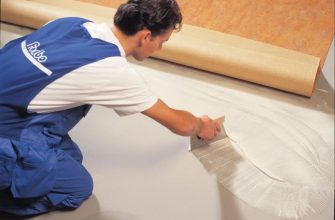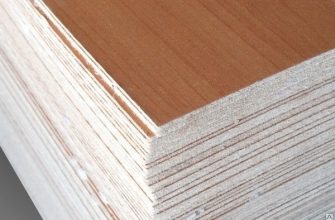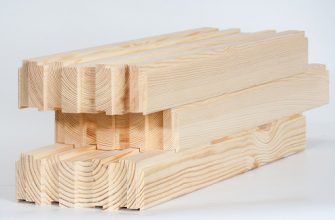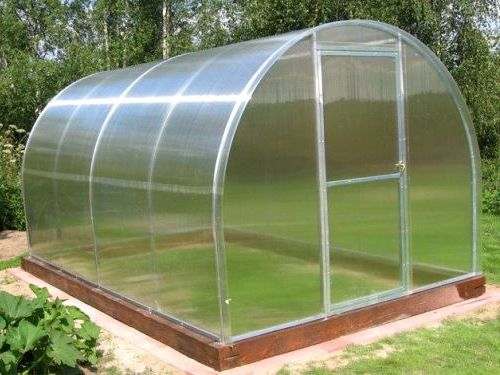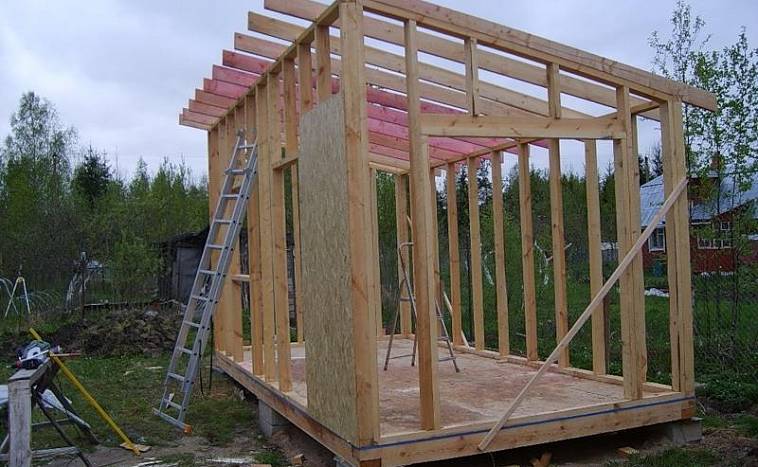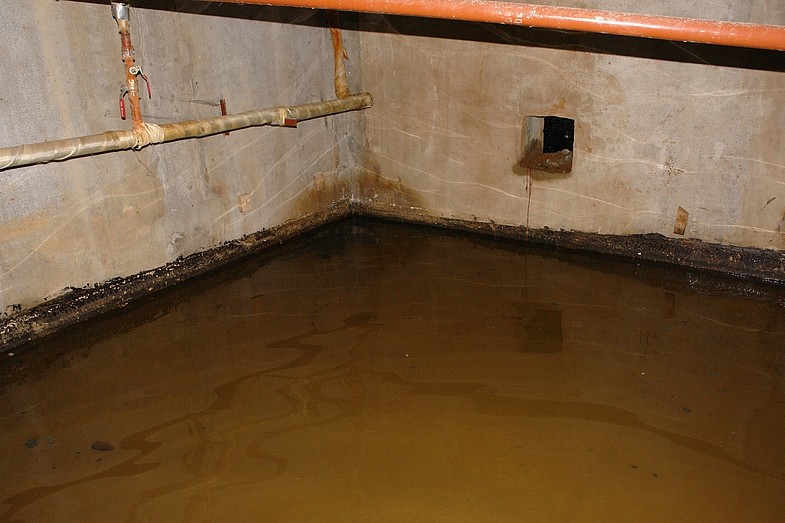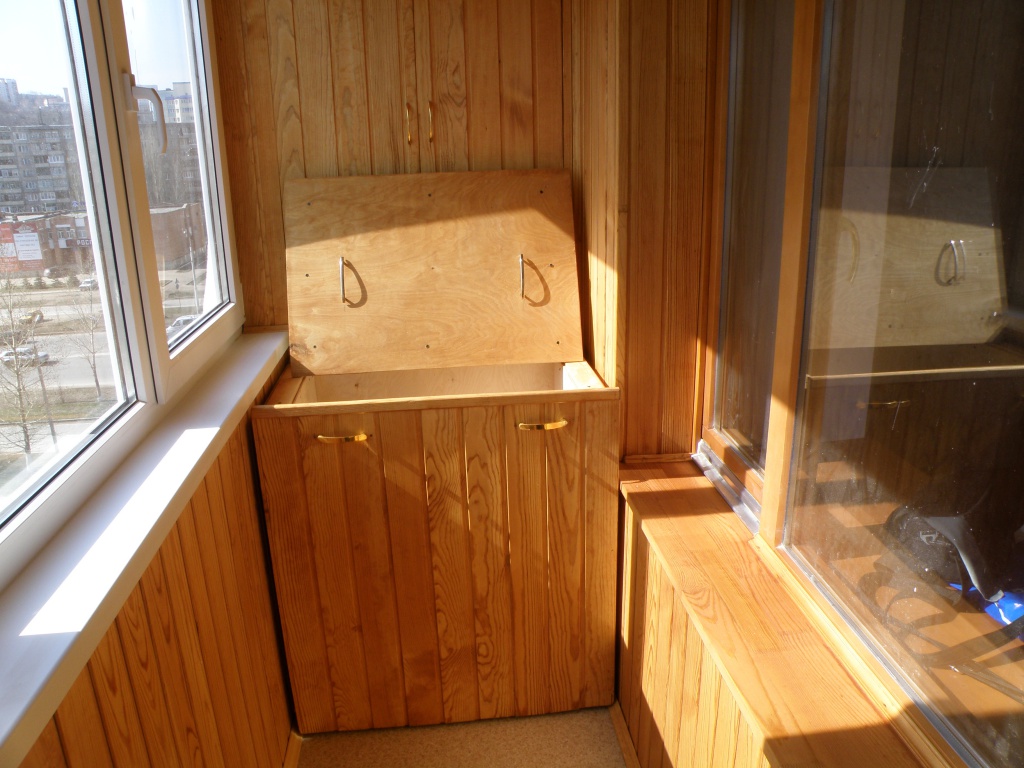The dog needs an enclosure for walking, in addition to a warm booth for living. The spacious playground makes it possible to lead an active lifestyle, as a result, appetite increases, vital signs increase. An aviary is built for a dog in an apartment or in the yard in order to train the animal, while partially restricting its movement. The pet should not perceive the site as a cage.
Design features
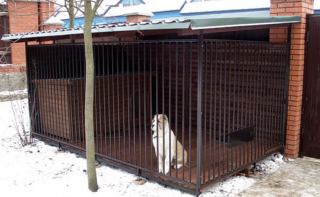
Fenced areas are made next to or around the houses to protect the pet from snow, rain, sunlight. The dimensions are made so that the owner can freely enter the aviary.
Consider the circumstances when choosing a design and dimensions:
- dog breed;
- pet's age, gender, height, body length;
- location relative to other buildings and wind roses on the site.
The fence is solid or half transparent. The interior equipment is designed for the leisure of dogs, especially puppies and juveniles.
Types of aviaries
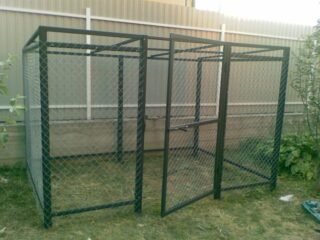
There are breeds that are contained only in an apartment or house, therefore, they distinguish a home enclosure for puppies and an outdoor enclosure in the form of a walking cage.
Indoor and outdoor pens are:
- open type;
- with a canopy, roof or canopy.
Usually open large squares, sometimes only part of the enclosure is closed to allow food to be taken in bad weather. Construction technology and construction of closed types depend on specific conditions and needs.
Common types of playgrounds:
- The tent type aviary is suitable for small pets. During transportation, portable models turn into a bag where a dachshund is, a terrier when moving to a dacha. The disadvantage is the small dimensions of the installation, the need for regular cleaning.
- Home paddocks. Apartment types are necessary if the dog is whelping and needs to build a separate place where it will not be disturbed. Sometimes different animals are separated, for example, cats, dogs, decorative rabbits. The appearance of a small child requires limiting the activity of the pet.
- Street walks. Collected for large dogs from durable materials, steel mesh is often used. The animal does not feel imprisonment, since it moves freely around the site, at the same time the guard sees targets approaching the yard, and reacts accordingly.
- Temporary barriers. They are placed when organizing exhibitions, for pair breeding. Summer enclosures are built for raising puppies and organizing their training.
- Closed corrals. Assume 2 - 3 solid blank walls with a solid roof. The open side is fenced off with an iron grating so that the dog can hear the surrounding sounds and observe the area. In closed fences, seams are sealed with foam, caulked to remove drafts.
- Capital aviaries. Such structures have a boardwalk or adobe flooring, the panoramic side is sewn up with reinforced glass or polycarbonate over a mesh. The walls are insulated with an insulator from the cold, the film is placed against the wind.
In stationary capital structures, artificial heating is provided in full or only in a separate part. For temporary maintenance, there are also lightweight structures that are made collapsible. They are stored in parts in a barn, if necessary, collected according to the scheme.
Aviary requirements
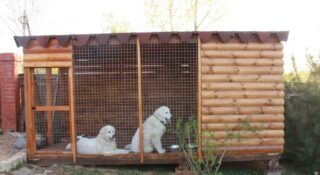
Dog walking, organized according to the rules, prevents diseases, colds, and injuries of the pet. The correct enclosure for animals consists of three functional areas: a wooden house, an open area, and a part under a canopy.
Requirements are made to the aviary:
- compliance with zoohygienic standards on the issue of heat, illumination, humidity;
- the door opens to the inside of the structure;
- one wall provides an overview of the courtyard;
- walls are built from environmentally friendly materials.
For the roof, materials are used that have a low heat capacity, for example, slate, ondulin, bituminous tiles.
Calculation of the size of the dog enclosure according to the main parameters
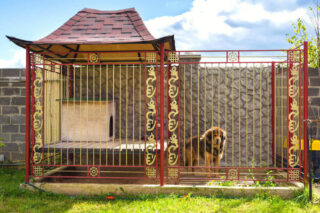
The dimensions of the site depend on the size of the dog, its mobility. Take into account the possibility of location on the site, the availability of free space. The height of the walls of the open part is made such that the dog cannot jump over the fence. Some breeds can cover up to three meters.
Recommended dimensions:
- for large dogs (over 65 cm tall) the minimum area is 10 - 15 m²;
- for average mongrels (height at the withers 50 - 65 cm) 9 m² is enough;
- small ones (height below 50 cm) will have an active rest on an area of 6 - 7 m².
It is advisable to build a rectangular pen with a side ratio of 2: 3. Before construction, a small project is drawn up in the form of drawings with a plan and vertical marks. The covered part is made in the third part of the pen, because The pet is most active in good weather. A bowl, a container of water is placed under a canopy, they are placed not far from the booth.
The number of individuals simultaneously on the site is taken into account. If the mother is planning to live with the puppies, the aviary is made more spacious, provide an appropriate booth. For small puppies, the size is made at the rate of 10 heads per 1 m².
Paddock floor
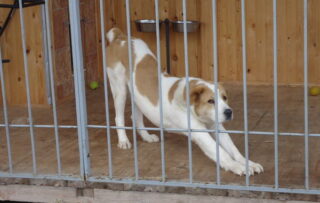
Outdoor dog enclosures should have artificial turf, which is only laid in the covered parts of the walk.
Materials used:
- boardwalk;
- concrete;
- asphalt;
- clay.
Concrete is often poured, but such a coating brings nothing but convenience for the owner. The layer is harmful to the paws of animals, they get sick. The board is ideal, edged and grooved types are used. The wood does not cool too much in winter, it maintains a comfortable temperature in the heat.
Clay with sand is also an environmentally friendly layer suitable for an aviary. Be sure to leave an area of untouched soil with grass, where the dog is most comfortable. Asphalt is of average usefulness.
Walls
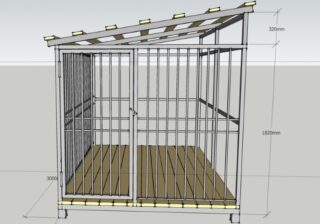
The decision on the number of blank walls in the pen is made by the owner, but at least one such fence should be. The vertical structure is built of brick or wood, sometimes covered with sheets of old slate. To save money, an aviary is attached to the wall of a house, another building, an internal fence is used on the site.
The rest of the sides are covered with a metal mesh, often using a "netting". For large dogs, the net is not always suitable, since they can injure the mouth, trying to gnaw through the rods. In this case, it is better to weld a grid of reinforcement with a diameter of 6 mm. The mesh or lattice is hung on iron pillars, round or shaped pipes are used.
Roof
For the main roof, a rafter structure is made, trusses are built, which are supported on load-bearing walls or pillars. Use a profile square or rectangular pipe, wooden bars and slats. The step of the beams, rafter legs and lathing elements is taken depending on the severity of the roofing material, the quadrature and the slope of the slope.
Small awnings and canopies are made lightweight. For them, they put up racks of iron and wood, which are connected with transverse beams. For covering, roll materials are used, awnings are used. Sheets of metal, corrugated board, metal tiles are not recommended, because.get very hot. It is stuffy under them in summer, especially with a low canopy height.
Doors
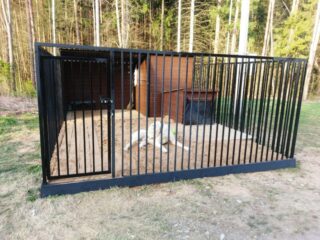
The entrance to the enclosure is needed not only by the animal, but also by the owner, therefore, the dimensions are used in width of 0.7 - 0.85 m, in height they make 2.05 - 2.10 m.Internal opening is provided so that the dog does not run out at the moment the owner enters ...
The structure must be solid. The gate is made of wood or metal, these materials are combined. Pillars are boiled from a profile pipe with a cross section of 60 x 80 mm, or bars with a transverse size of 100 x 80 mm are buried in.
The canvas is collected strong, hung on two or three loops. The frame contains a strapping around the perimeter, crossbars or diagonals are mounted inside for rigidity. On the outside, a reliable bolt is provided that will not loosen from the blows of dog's paws on the gate.
Aviary booth
The dimensions of the booth are chosen according to the growth of the pet, which are measured in a standing position. Determine the height at the withers, body length, chest width. Depending on this, the width, depth and height of the house are taken.
Booth requirements:
- the dog should lie down to its full height, but too spacious dwellings lead to a loss of heat, which is generated by the dog's body;
- the booth is placed on supports so that it does not freeze from the ground, does not become saturated with moisture;
- insulate all enclosing surfaces (walls, floor, roof).
The inner surfaces are sheathed with hard material so that the dog does not bite into the insulation or upholstery. The manhole into the booth is closed with a canopy made of durable and warm material. The roof is made single-pitched or gable, it is better to assemble a removable or folding version.
Internal organization of space
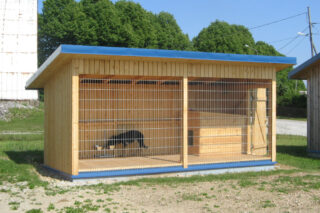
An open area is left for the toilet, unless daily walking is planned in another place. The dog will choose a place from where it will need to remove excrement daily.
Feeding organization rules:
- the feeder is raised above the floor or ground, so that the dog does not lower its neck when eating;
- provide a separate container for water, set it so that it does not mix with food;
- ideally, if the owner has access to the feeder without going into the aviary, this is how the exhaust structure works.
Cleaning the enclosure is made easier by making a sloped floor or area. In this case, it is enough to spill the plane with water from a hose, all the debris will roll down along with the jets. Provide night lighting.
Corral location
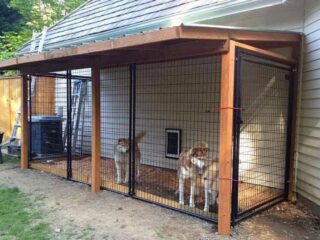
The capital enclosure is designed for long-term residence of dogs, so it is placed so that it is convenient not only for the owner, but also for his pet. The needs for lighting, play, food, communication with nature must be met.
Prohibited areas of the yard:
- close to outbuildings where there is a lot of noise and strong odors, for example, a pigsty, a poultry house, a garage, a workshop, a toilet, a compost heap;
- next to a street fence - the dog will constantly bark at passers-by and vehicles;
- in the lower part of the yard, where rain and melt runoffs accumulate.
The aviary is located near the front of the yard so that the pet can see the entrance gate, gate, door to the house. An open enclosure without a roof is placed in the shade of a spreading tree so that the pet can walk in the summer afternoon.
Features of enclosures for puppies and small dogs
Small pets also require their own space for walking, so they build an aviary for small dogs in the apartment. As in street walking, there is a closed sleeping area (booth) and a place for active action.
Placed in the corral:
- litter;
- drinker, bowl;
- toilet tray;
- toys.
For a family member who is a small dog, an aviary is not always needed. But guests come, other people's children, so the animal must have a territory where it is safe and calm.

